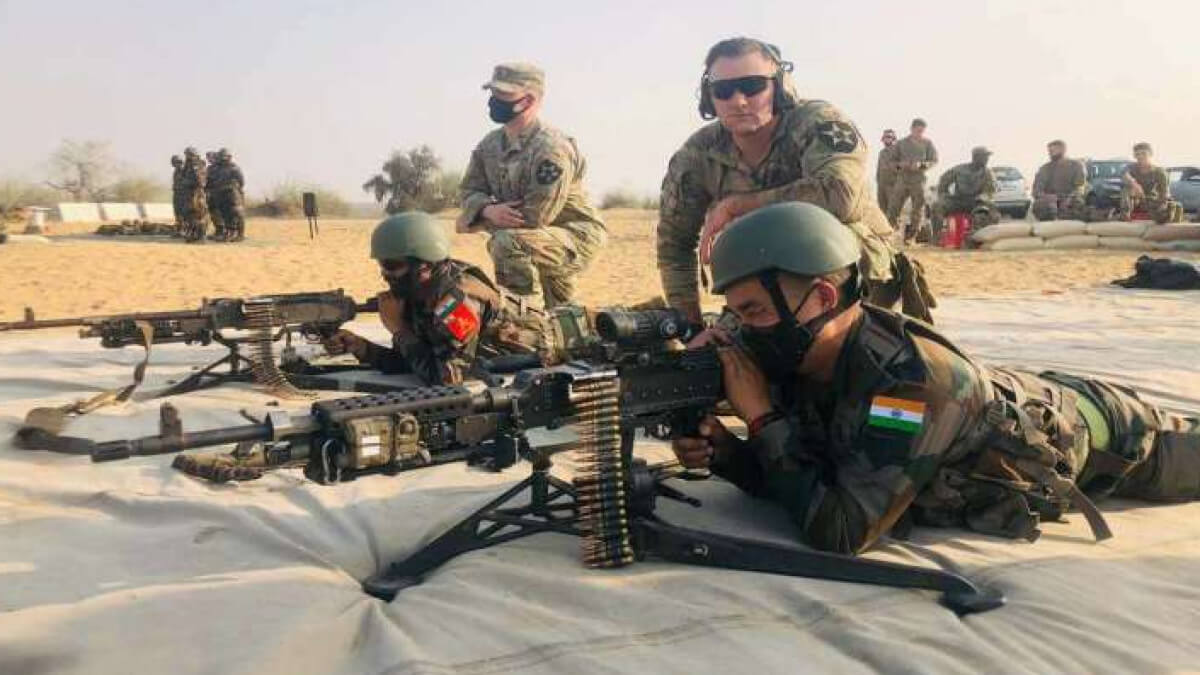India and the United States (US) began the 18th edition of the 15-day Yudh Abhyas II joint training exercise on 16 November, just 95 kilometres from the Chinese border in Auli as tensions between New Delhi and Beijing remain high over stalled de-escalation talks.
An Indian statement by the Indian Ministry of Defence said that the exercise facilitates the exchange of “best practices, tactics, techniques and procedures between the armies of the two nations.” It will also include training for peacekeeping and peace enforcement operations, along with humanitarian assistance and disaster relief training.
India and the US launched the exercise in the early 2000s in pursuance of four military-level agreements signed between 2002 and 2020 that sought to increase communication and interoperability. India and the US alternatively host the exercises, with the US hosting the previous edition at Joint Base Elmendorf Richardson in Alaska.
#IndianArmy and @USArmy troops kick off #YudhAbhyas22 with an opening ceremony in Auli, India.
— I Corps (@I_Corps) November 19, 2022
This year, the bilateral exercise is held in the Himalayas, where @11thAirborneDiv will train alongside 71st Mountain Bde, @adgpi in extreme high altitude. @USARPAC @INDOPACOM pic.twitter.com/U4znuna6Qh
The 11th Airborne Division from Alaska participated in this year’s exercise. They specialise in operating in extremely cold and mountainous regions, making the training relevant for India’s goal of preparing for warfare in the arduous conditions along the border with China.
Major General Brian Eifler, a commander in the division, said, “The Army typically doesn’t go to the Himalayas, and now we have an Arctic force and we’re training in the Arctic. We feel confident that we could do things like that now that the Army couldn’t do before.”
In fact, US Army Pacific Commanding General Charles Flynn said during his visit to India in June that the two armies will focus on training at an altitude of 9,000 to 10,000 feet to prepare for high-altitude warfare. He noted that these engagements are especially crucial in light of China’s “corrosive and destabilising behaviour.”
Photo-gallery: #YudhAbhyas #Alaska pic.twitter.com/gSqbcIf1ym
— Neeraj Rajput (@neeraj_rajput) October 29, 2021
The US army has sent 30,000 sets of “extreme cold-weather gear” to the Indian army over the past few years to help prepare for military operations at high altitudes.
In other related developments, India will participate in the Austra-Hindu combat exercise with Australia in Rajasthan from 28 November to 11 December. The military is also in the middle of the Agni Warrior exercise, which began on 13 November and will be completed at the end of the month, with Singapore.
The Yudh Abhyas exercise comes against the backdrop of India and the US’ rising tensions with China.
Arzan Tarapore, South Asia research scholar at Stanford University's Shorenstein Asia-Pacific Research Center, told Business Insider: “The US and India probably anticipated that conducting the exercise near the Chinese border would draw Beijing’s ire. It sends a useful hint — to both China and equally the Indian Army — that the US appreciates India's security concerns on the border.”
“But as far as political signalling goes, the US and India have still left some room to escalate — while this iteration is near the border, it is not near disputed stretches of the LAC or near recent crisis areas,” he added.
Spartan Paratroopers and Indian Army soldiers had the opportunity to familiarize themselves with each other's weapon systems to enhance their understanding of capabilities during Yudh Abhyas, Nov. 20.@adgpi @DeptofDefense .@USARPAC_CG pic.twitter.com/xHPuX3bH6z
— U.S. Army Pacific (@USARPAC) November 23, 2022
The drills take place along the Line of Actual Control (LAC), which has remained a controversial issue for India and China since the 1962 war. After years of relative peace, the deadly Galwan Valley clash in 2020, which killed 20 Indian soldiers and as many as 45 Chinese soldiers, has reignited tensions.
Since the incident, India and China have participated in several commander-level discussions to push for the disengagement of troops and equipment from the previously agreed-upon regions. In fact, the two sides began the disengagement process at Gogra Hot Springs (PP-15) on 8 September as per an agreement reached at the 16th round of the India-China Corps Commander Level Meeting in July.
They withdrew troops and took down temporary infrastructure set up along the LAC for the first time since the 2020 clash.
Indian commentators, however, have cautioned against interpreting the Gogra Hot Springs as a reset in India-China ties. For instance, military affairs expert Lieutenant General DB Shekatkar has said, “Given the experience of dealing with China, we have to be cautious. Over the last three decades, India has signed several agreements with China for border peace, but it has always betrayed us.”
The two sides remain deadlocked in discussions on the Depsang Bulge in the Daulet Beg Oldi sector and the Charding Nullah Junction (CNJ) in the Demchok sector. They also continue to maintain around 60,000 troops along the LAC.

